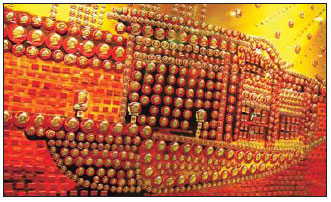Society
Badge of honor in the New China
By Zhu Linyong (China Daily)
Updated: 2011-06-25 08:50
 |
Large Medium Small |
|
 |
|
On display includes a badge portrayal of the wooden ship where the first meeting of the earliest CPC members was convened on South Lake in Jiaxing, eastern Zhejiang province, in 1921. |
But it was not until 1966 that Mao badges became the most widely circulated cultural icon of the time in China - and that the art of badge-making reached its peak in quantity, varieties, craftsmanship, and aesthetic value, Zhao said.
Chairman Mao badges were mass-produced and worn by everyone, from the smallest child to Prime Minister Zhou Enlai, as an expression of loyalty to the Chinese leader.
They have long been collectors' items. It is estimated that 200 million to 300 million badges have survived the test of time.
After Mao's death in 1976, Mao badges became less popular for some time. Most families and badge-owners kept them, sometimes stashing them away in boxes or drawers.
On Nov 19, 1982, the 25th session of the Standing Committee of the Fifth National People's Congress approved the Law on the Protection of Cultural Relics, placing Mao badges made during the "cultural revolution" on the list of modern relics.
The Mao badge has been very popular again since the 1990s.
Across China, badge study associations and related websites have emerged, and there are an estimated 2 million or more badge collectors on the Chinese mainland.
Zhao has more than 2,000 varieties of Mao badges in 300 major categories, a collection unrivaled by any other individual collector. "In my view, the sweeping popularity of Mao images embossed on badges, pins and daily items is a cultural phenomenon that deserves the attention of scholars and collectors today," Zhao said.
"Tiny as they are, the Mao badges reflect a nation's collective memory and mentality during a special, historic period, which needs serious examination."
While the Mao badges are a product of a bygone era - and for some people are evidence of a Mao cult - Zhao says that they reflect the Chinese people's sincere appreciation of the paramount leader in the early years of the New China.
"Our museum is open to everyone. ... It may help people to learn about the history of Communist Party of China and a realistic view of the founding process of the New China."
| 分享按钮 |